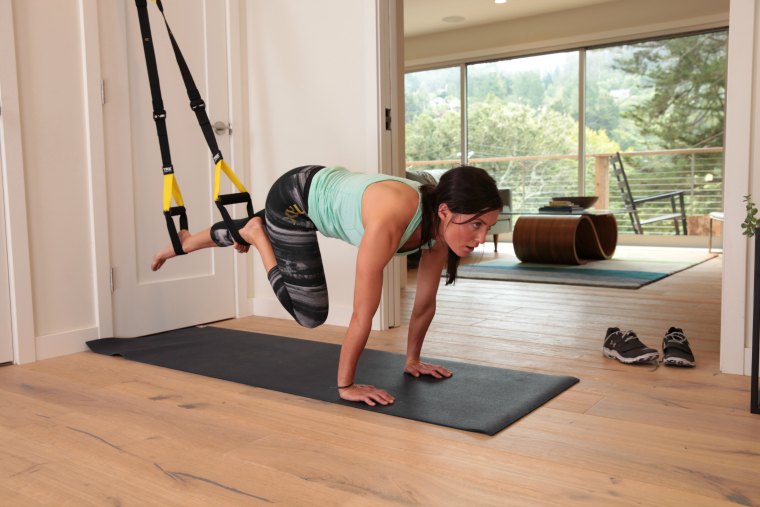Home Workouts: What’s In Your Gym?

Getting fit doesn’t have to cost much. A pair of sneakers, a sports bra and the motivation to go get sweaty, and you’re well on your way.
That being said, there are a lot of opportunities to spend some dough on fitness, so I try to be smart about where and how I’m spending my fit bottomed dollars. I love going to pay-per-class workouts, but I try to stick to just one (or maybe two) a week to stay on budget.
And that means that I do a number of workouts at home.
I know not everyone can get down with working out at home, either alone or with a partner, but I love it. I use the classes I attend to learn new exercises and get feedback on form, and then I create home workouts using either the moves I love most or, more often, the ones I know I really need to work on. I have zero trouble putting together (and completing) a tough workout on my own … as long as I have the right tools.
But, when it comes to tools for your home workout, what are you willing to spend? I’d make the argument that, if you’re serious about working out at home and know you’ll be doing a lot of that vs. spending $10 to $20 per class, it might be worth investing some pretty significant cash into the equipment you’ll be using for your home workouts, if your budget allows.
Unless you have unlimited funds (and unlimited space!), I think it’s really important to focus on items that perform in multiple ways. I’ve had a chance to review three products that fit that bill recently and wanted to share my thoughts.
FitnessMat
When you’re at the gym, you’re probably on a floor that offers a bit of give and support, and for a lot of the moves you’re doing at home, you should have the same. If covering your floor with rubber isn’t a good option (and I can tell you right now that it won’t fly in my house), having a large, non-slip mat is a must.

FitnessMat
The FitnessMat ($149.95-$239.95) is a really high-quality option. It’s quite cushy, but not too soft for balance work. It’s long and wide enough (especially in the large size) to work for stationary jumps and for dropped weights. And, for my clean freaks out there, it’s inherently antimicrobial and easy to sanitize.
It’s designed to be non-slip on top and bottom, although I found my hands and bare feet slid a bit if I didn’t use a yoga towel. I really loved the suspension it offers, though — for yoga and for strength work, for sure, but especially for any moves I do on my (not-so-great) knees. No standard yoga mat comes close to that comfort.
Personal Power Plate
So, this is pretty exciting. You might’ve used a Power Plate for whole-body vibration training at the gym or with a personal trainer — I know that was my only experience with it previously. Well, now they’re offering a personal version to be used at home!

Power Plate
The Personal Power Plate ($1,995) is certainly an investment, but consider this: Vibration training is designed to increase the efficiency of your workouts (so, faster results in less time) and it facilitates recovery. It’s not hard to carve out 10 to 15 minutes a few times a week right in the comfort of your own home — seriously, anyone can do that. So, even though the price point is high, for someone who’s a fan of vibration training and can afford to invest in a good piece of equipment? Yeah, it totally makes sense.
Plus, it’s easy to use — you just set it up on hard floor (not carpet!) and use the little remote to set the intensity of the vibration (low or high) and the time (30 or 60 seconds). Then, you do your exercises — and if you don’t know what to do, don’t worry because I’ll be sharing a few moves on it coming up soon! It honestly could not be simpler.
TRX Home Suspension Trainer
It’s not going to surprise a soul that I’m in love with my TRX Suspension Trainer ($179.95). Heck, I love it so much that I got certified to train people using it. So, if I’m talking about equipment to keep in your home gym, it’s definitely nabbing a spot. And here’s why.

TRX Suspension Trainer
It takes up very little room for storage (like, I’ve kept mine in a drawer), and while it’s ideally used from an anchor point that’s 7 to 9 feet high, you can also anchor it from any door that closes securely (so you can easily take it with you and use it on the road). It can be used to make a lot of moves more challenging by decreasing stability, but it’s equally useful when it comes to making certain things easier (like yoga) or taking load off of weight-bearing exercises. If there’s a muscle you can’t target using the Suspension Trainer, you’ll have to tell me about it because so far I haven’t found one.
Other recommendations I’d have to make: a kettlebell, a set of light and a set of heavy dumbbells, and a jump rope.
What would you spend on a piece of equipment for your home gym? —Kristen
